
Using ragweed and wingstem as mulch
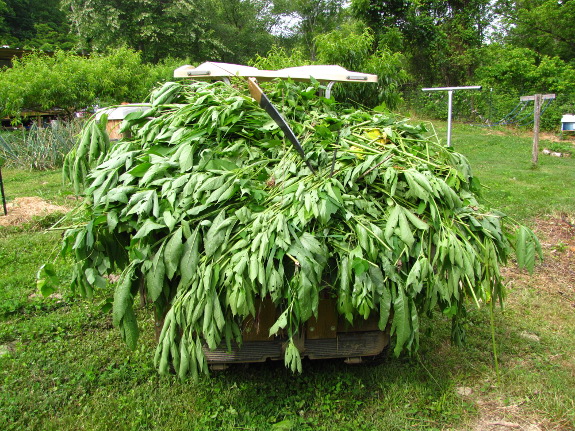
Our farm grows wingstem
and ragweed better than anything
else. Although our honeybees visit the flowers, we don't get
any other products from these acres and acres of
wildflowers...until now.
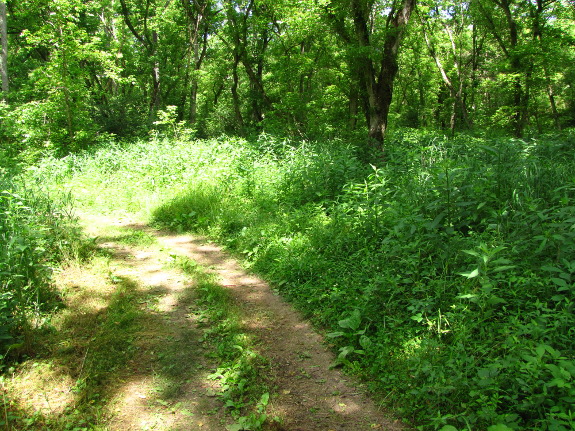
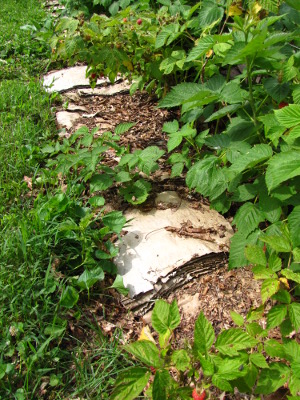 The tall weeds that line our
driveway have always looked like an opportunity, but I never could
figure out what they were an opportunity
for. One winter, I gathered the dead stalks and sent them through
our shredder/hammer
mill, but the
process took forever and I was worried that the seedy mulch would cause
problems.
The tall weeds that line our
driveway have always looked like an opportunity, but I never could
figure out what they were an opportunity
for. One winter, I gathered the dead stalks and sent them through
our shredder/hammer
mill, but the
process took forever and I was worried that the seedy mulch would cause
problems.
At this time of year,
though, ragweed and wingstem are shooting up fast and have no flowers
or seeds in sight. Add in the scythe and a bed of raspberries
that the chicks had scratched nearly bare, and I thought I might have
figured out my opportunity.
It took me about an hour
(and two big golfcart loads) to cover up the cardboard of my kill mulch
with a new organic layer. I mulched very thickly since I know the
weed leaves will wilt down to nearly nothing, but I hope the stems will
be enough to provide a long-lasting mulch. That means it took
just a bit longer to mulch the row than if we'd hauled buckets
of composted wood chips from the parking area, but only about half as long
as raking
leaves out of the woods.
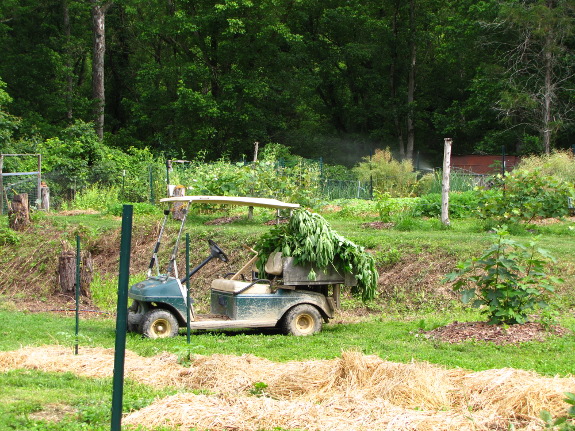
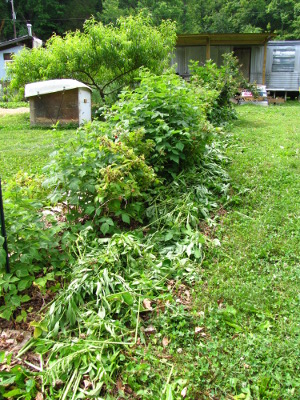 The trick to speedy weed
gathering was to hit spots right along the driveway where partial shade
keeps the vines down and allows the scythe to make short work of the
weed stalks. Actually, I spent a lot more time collecting the
weeds off the ground than cutting them down, meaning that if I wanted
to build a grain
cradle for the
scythe, I could probably become significantly more efficient.
The trick to speedy weed
gathering was to hit spots right along the driveway where partial shade
keeps the vines down and allows the scythe to make short work of the
weed stalks. Actually, I spent a lot more time collecting the
weeds off the ground than cutting them down, meaning that if I wanted
to build a grain
cradle for the
scythe, I could probably become significantly more efficient.
I also suspect that I'd
get more biomass for my effort if I waited another few weeks until the
weeds were starting to bloom. At that stage, they'd be higher in
carbon, which would make the mulch last longer while encouraging
beneficial fungi in the soil. Right now, the shaded wingstem and
ragweed in the woods are between three and five feet tall, but they'd
be bigger at bloom time.
I'll try to remember to
report back once I get an idea about how well the weeds work as
mulch. I'll probably repeat the experiment in a few other patches
in the meantime --- scything combined with the golf cart is too much
fun to pass up.
Want more in-depth information? Browse through our books.
Or explore more posts by date or by subject.
About us: Anna Hess and Mark Hamilton spent over a decade living self-sufficiently in the mountains of Virginia before moving north to start over from scratch in the foothills of Ohio. They've experimented with permaculture, no-till gardening, trailersteading, home-based microbusinesses and much more, writing about their adventures in both blogs and books.
Want to be notified when new comments are posted on this page? Click on the RSS button after you add a comment to subscribe to the comment feed, or simply check the box beside "email replies to me" while writing your comment.

You mentioned waiting a bit longer as to let the weeds grow some more... Joel Salatin of Polyface farms does this with the grass in his cow pastures. He says there is the "infant" stage, followed by the "teenager" stage, and then the nursing home stage in plant growth. Tongue in cheek… He waits to graze his cows on a pasture until the grass is past the "teenager" stage which is where the most growth occurs. Mr. Salatin raises cows, chickens, rabbits, and various crops, but refers to himself as a grass farmer.
It looks like you grow ragweed and wingstem like we grow lambs quarter. Sometimes I feel like I’m fighting a hostile take over; the stuff grows everywhere at our place!
Chris --- I found Greener Pastures on Your Side of the Fence even more helpful for an in-depth understanding of grass growth rates over time.
Mitsy --- The goal in cases like this (and when mow-killing cover crops) is to hit the plants right before the flowers turn into seeds. That way, you get more carbon, take advantage of the peak growth of the plant, and in the case of some cover crops make the plant more likely to die on its own, all without seeding your garden with things you'd rather keep out.
How do you identify pasture grasses/forbs/weeds etc? Do you have any resource suggestions? Would you consider doing/have you done a pasture identification post?
We JUST move to a farm in SW Virgnia and I am struggling to identify many of the plants that are growing!
Emily --- Welcome to southwest Virginia! Where is your new farm?
I've considered doing an ID series on pasture plants, but there are just so many options, and the grasses are so tough! I recommend getting a copy of Peterson's Field Guide to Wildflowers. It's easy for beginners to use and will help you ID most of your common plants, except those pesky grasses.
I'm actually still working my head around grasses myself, and the best advice I can give you is to figure out who the most likely candidates are and learn those first. Fescue and bluegrass seem to be the most common ones in mowed areas here, but hayfields and other areas that are allowed to get taller have a whole different set of species. Your extension agent might be able to help you out if you bring in plants to be IDed.
Good luck!